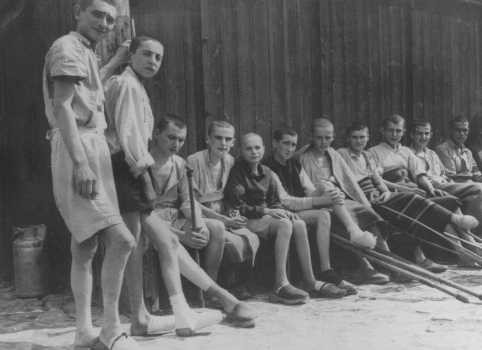
Youth Camps
By a decree of the Reich Ministry of the Interior in May 1939, a new Reich Center for Combating Youth Criminality became a department in the Reich Criminal Police Office. It was tasked with the police surveillance of youths. It had the power to use force, including sending youths to closed reform institutes. It would later be in charge of the “police youth protection camps” for young people who were deemed to have strayed from Nazi norms and ideals.
The idea of establishing a separate prevention institution (Bewahranstalt) or assembly camp (Sammellager) for the “difficult or impossible to educate” youth, who had become noticed because of their stubborn and deviant behavior, was not new. From the mid-1920s, youth welfare workers, lawyers, medical practitioners, psychiatrists, and adherents of the “racial hygiene” movement had been demanding such institutions to deal with the high level of care (and thus expense) for such youths. Without any further education, they would be held for an indefinite period of time in such institutions with their labor being exploited. Those advocating such a policy were not successful during the Weimar Republic, but this changed from 1933 with the assumption of power by the National Socialists and the establishment of the concentration camp system.
A series of decrees and orders from 1937 set the legal and institutional basis for the struggle against youth degeneration. A decree dated October 14, 1937, on “preventive criminal measures” established what was regarded as “asocial behavior,” which was “someone who acts against the community, even if such actions were not criminal, but showed that he or she did not want to be part of the community.” This decree formed the basis for the persecution of anyone who deviated from National Socialist norms and ideals. In 1938, there followed a further series of decrees and regulations that dealt with the treatment of asocials and called for the “protective custody” of whole families as well as suggesting the registration and police surveillance of asocials.
Following a circular decree by the Reich Ministry of the Interior (RMdI) on May 24, 1939, the Reich Center for Combating Youth Criminality (Reichszentrale zur Bekampfung der Jugendkriminalitat) was established as a department of the Reich Criminal Police Office (Reichskriminalpolizeiamt, RKPA). This authority was tasked with the police surveillance of youths and the power to use force, including sending youths to closed reform institutes. Later, it would be in charge of the “police youth protection camps” (polizeiliche Jugendschutzlager). In actuality, they were concentration camps for youths. On December 22, 1939, at a conference on “degenerate youth,” Reinhard Heydrich demanded the establishment of reform camps for youths (Jugenderziehungslagern). This demand was supported in the following months by Hermann Göring and Heinrich Himmler. On June 26, 1940, the Reich Security Main Office (Reichssicherheitshauptamt, RSHA) issued a circular announcing that the confinement of youths to police youth protective custody camps could begin within a short period of time. In the end, three such camps opened: Moringen (for boys) in August 1940, Uckermark (for girls) in June 1942, and Litzmannstadt (for Polish juveniles) in December 1942. All remained in operation almost until the end of the war.
Youths were admitted to the Jugendschutzlager on racial, religious, or political grounds. They included the so-called Hamburg Swing Youth (Swing-Jugend), who were accused of establishing a dangerous clique even though they only wanted to listen to jazz, then regarded as un-German, and had formed their own subcultures to do so. The authorities also confined gay men, Sinti and Roma (Gypsies), Jews, and Jehovah’s Witnesses.
Youths in the camps were subjected to military drill, euphemistically termed “community training” (Gemeinschaftserziehung). The stated aim was character education, focusing on cleanliness, order, punctuality, discipline, and above all, work. The inmates worked on agricultural estates, at armaments firms, and at workshops of various sorts. Living arrangements were primitive, the food and clothing inadequate, and the punishments severe. Death rates were not as high as in some of the adult concentration camps, but prisoners did die in significant numbers.
Footnotes
-
Footnote reference1.
Quoted in Detlef Peukert, Volksgenossen und Gemeinschaftsfremde. Anpassung, Ausmerze und Aufbegehren unter dem Nationalsozialismus (Cologne, 1982), p. 250.

